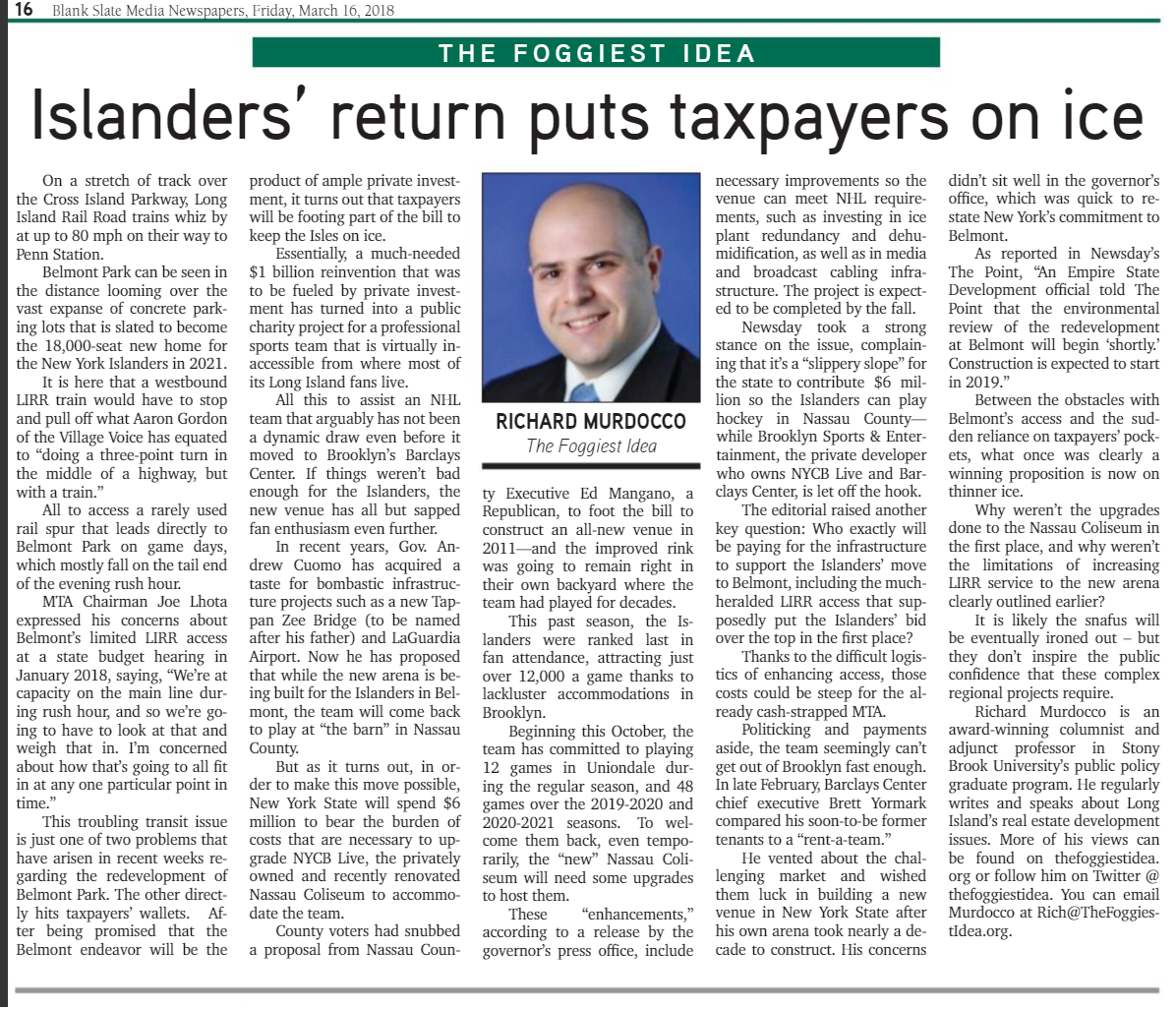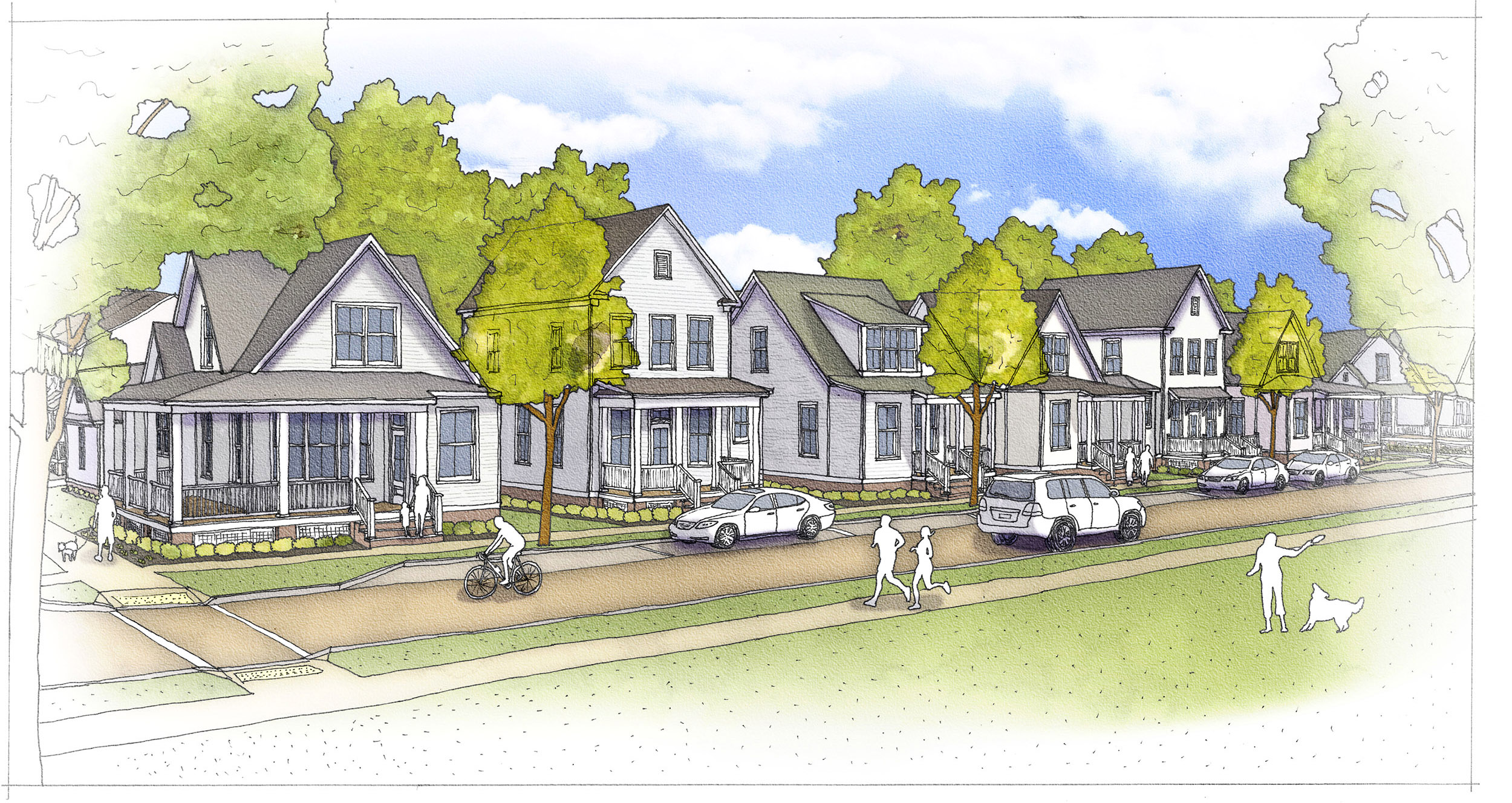The following was first published by The Foggiest Idea on March 6, 2018. The Island Now/Blank Slate Media reprinted the piece in the March 16, 2018 edition of their papers. You can read their version here.
On a stretch of track over the Cross Island Parkway Long Island Rail Road trains whiz by at up to 80 mph on their way to Penn Station. Belmont Park can be seen in the distance looming over the vast expanse of concrete parking lots that is slated to become the 18,000-seat new home for the New York Islanders in 2021.
It is here that a westbound LIRR train would have to stop and pull off what Aaron Gordon of the Village Voice has equated to “doing a three-point turn in the middle of a highway, but with a train.” All to access a rarely used rail spur that leads directly to Belmont Park on game days, which mostly fall on the tail end of the evening rush hour.
MTA Chairman Joe Lhota expressed his concerns about Belmont’s limited LIRR access at a state budget hearing in January 2018, saying, “We’re at capacity on the main line during rush hour, and so we’re going to have to look at that and weigh that in. I’m concerned about how that’s going to all fit in at any one particular point in time.”
This troubling transit issue is just one of two problems that have arisen in recent weeks regarding the redevelopment of Belmont Park. The other directly hits taxpayers’ wallets. After being promised that the Belmont endeavor will be the product of ample private investment, it turns out that taxpayers will be footing part of the bill to keep the Isles on ice.
Essentially, a much-needed $1-billion reinvention that was to be fueled by private investment has turned into a public charity project for a professional sports team that is virtually inaccessible from where most of its Long Island fans live.
All this to assist an NHL team that arguably has not been a dynamic draw even before it moved to Brooklyn’s Barclays Center. If things weren’t bad enough for the Islanders, the new venue has all but sapped fan enthusiasm even further.
In recent years, Gov. Andrew Cuomo has acquired a taste for bombastic infrastructure projects such as a new Tappan Zee Bridge (to be named after his father) and LaGuardia Airport. Now he has proposed that while the new arena is being built for the Islanders in Belmont, the team will come back to play at “the barn” in Nassau County. But as it turns out, in order to make this move possible, New York State will spend $6 million to bear the burden of costs that are necessary to upgrade NYCB Live, the privately owned and recently renovated Nassau Coliseum to accommodate the team. County voters had snubbed a proposal from Nassau county Executive Ed Mangano, a Republican, to foot the bill to construct an all-new venue in 2011—and the improved rink was going to remain right in their own backyard where the team had played for decades.
This past season, the Islanders were ranked last in fan attendance, attracting just over 12,000 a game thanks to lackluster accommodations in Brooklyn. Beginning this October, the team has committed to playing 12 games in Uniondale during the regular season, and 48 games over the 2019-2020 and 2020-2021 seasons. To welcome them back, even temporarily, the “new” Nassau coliseum will need some upgrades to host them. These “enhancements,” according to a release by the governor’s press office, include necessary improvements so the venue can meet NHL requirements, such as investing in ice plant redundancy and dehumidification, as well as in media and broadcast cabling infrastructure. The project is expected to be completed by the fall.
Newsday took a strong stance on the issue, complaining that it’s a “slippery slope” for the state to contribute $6 million so the Islanders can play hockey in Nassau County—while Brooklyn Sports & Entertainment, the private developer who owns NYCB Live and Barclays Center, is let off the hook. The editorial raised another key question: Who exactly will be paying for the infrastructure to support the Islanders’ move to Belmont, including the much-heralded LIRR access that supposedly put the Islanders’ bid over the top in the first place? Thanks to the difficult logistics of enhancing access, those costs could be steep for the already cash-strapped MTA.
Politicking and payments aside, the team seemingly can’t get out of Brooklyn fast enough. In late February, Barclays Center chief executive Brett Yormark compared his soon-to-be former tenants to a “rent-a-team.” He vented about the challenging market, and wished them luck in building a new venue in New York State after his own arena took nearly a decade to construct. His concerns didn’t sit well in the governor’s office, which was quick to restate New York’s commitment to Belmont. As reported in Newsday’s The Point, “An Empire State Development official told The Point that the environmental review of the redevelopment at Belmont will begin ‘shortly.’ Construction is expected to start in 2019.”
Between the obstacles with Belmont’s access and the sudden reliance on taxpayers’ pockets, what once was clearly a winning proposition is now on thinner ice. Why weren’t the upgrades done to the Nassau Coliseum in the first place, and why weren’t the limitations of increasing LIRR service to the new arena clearly outlined earlier?
It is likely the snafus will be eventually ironed out – but they don’t inspire the public confidence that these complex regional projects require.
Richard Murdocco is an award-winning columnist and adjunct professor in Stony Brook University’s public policy graduate program. He regularly writes and speaks about Long Island’s real estate development issues. More of his views can be found on thefoggiestidea.org or follow him on Twitter @thefoggiestidea. You can email Murdocco at Rich@TheFoggiestIdea.org.











It should be noted the right-of-way for a full wye at the Long Island Rail Road junction for Belmont is still intact. A quick Google Maps aerial view shows a string of MOW cars laid up on that right-of-way. It would short-sighted on the MTA’s part to not consider that full wye…
Rita DeRose Mr. Murdocco seems to offer an objective assessment of the questionable manner in which the Belmont and Coliseum initiatives have unfolded or have been executed, but I find the final assessment too simplistic and highly suspect when he states “It is likely the snafus will be eventually ironed out..” Why does he limit all the many problems with these initiatives to one of confusion and complexity? How and by whom will the confusion be ironed out? In whose favor will it be ironed out? By whom and in what manner will this increased cost be shouldered? Murdocco goes on to state that though public confidence has been eroded, he attributes that erosion to the complexity of the regional projects, redirecting fault onto residents’ inability to understand that complexity, rather than onto the proposals themselves. In essence his message seems to be; yes, these initiatives are problematic but we should still proceed with them. Doesn’t that subliminal message of acquiescence silence opposition? Mr. Murdocco, are you playing us?
The only access to Belmont for the LIRR is from the west, and that will be very limited.